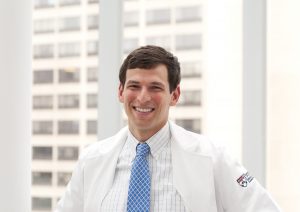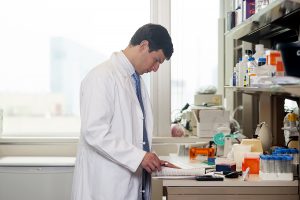On Friday, March 13, 2020, much of the United States shut down with COVID-19 restrictions. Three days later, Dr. David Fajgenbaum launched an effort to track and publicly share what drugs were being tried to combat the disease.
The CORONA (Covid-19 Registry of Off-label & New Agents) Project has been a valued resource ever since, keeping an inventory – in real time – of the now more than 500 treatments that have been administered to COVID-19 patients. Fajgenbaum led a team that has reviewed thousands of journal articles to identify the drugs, determine which are most promising at various stages, and make it all available through an open-source data repository.
In the past 18 months, more than 30,000 unique users have viewed the database, including members of the general public and officials from the National Institutes of Health and the U.S. Food and Drug Administration who have used the database to select drugs to test in clinical trials.
“All around the world, a lot of treatment of COVID has become very politicized and polarizing. Some people like this drug or that drug,” says Fajgenbaum, an associate professor at the University of Pennsylvania Perelman School of Medicine. “Our approach has been to put the data in one central place that anyone can touch and play with it. They can see why we give a drug a certain grade.”
The idea is to map out what is being tried to treat COVID-19, gather the studies that are being published, and to make that information available broadly.
“We should be pulling for every drug to work, but at the same time be rigorous in assessing whether it actually works or not,” says Fajgenbaum. The goal is not to name one drug that everyone should be on, but rather to highlight what the evidence shows is most promising. It’s an approach he sees has potential in other areas.
“I really think this concept of leveraging all the data available to make sure that every drug that is approved for something can be utilized for every disease that it can be helpful for is critical,” Fajgenbaum says. “I dream of being able to do what we’ve done for COVID for every single disease — simultaneously.”
Fajgenbaum believes in the power of openly sharing research to advance science – not just as a physician, but also as a patient himself.
In 2010, he was diagnosed with a rare immune condition called idiopathic multicentric Castleman disease (iMCD). Fajgenbaum was in medical school at the time and nearly died five times in three years from complications. “I ran out of all options that the medical community had identified. I realized my only chance for survival was to search for an existing drug that could be repurposed,” says Fajgenbaum, who did testing on himself and eventually found the defect in his immune system and a drug to fix it.
He has been in remission for more than seven years and his book, Chasing My Cure: A Doctor’s Race to Turn Hope Into Action, details his journey.
Fajgenbaum has since dedicated his career to studying immune cell disorders and treatment –embracing open data practices in medicine and bringing experts from around the world to work together on treatments. In 2012, he co-founded the Castleman Disease Collaborative Network (CDCN), which initially sponsored the CORONA Project.
When the pandemic hit, the 36-year-old who lives in Philadelphia with his wife and young daughter, hoped that some research group would apply the methods he’d developed to save his own life to help to identify the most promising drugs for COVID.
“I realized I shouldn’t hope for someone else to do it. I’m alive today because I stopped hoping for someone else to act,” says Fajgenbaum, who says the project gave him a sense of purpose during what felt like a hopeless time for many.
He started the CORONA Project with about 15 members of his CDCN team and 100 volunteer medical students. A $1 million grant from the Parker Institute for Cancer Immunotherapy has since enabled him to hire staff and expand operations. Next, the researchers plan to include information on treatment for long-term COVID-19 patients and they are seeking additional support to continue operations.
Fajgenbaum says the project illustrates the value of collaboration that could be applied to other conditions. Many diseases are being treated with off-label drugs, but there is no central open-source repository to track what works.
“I hope this is a paradigm moving forward for open science where all papers are free and open source,” Fajgenbaum says. It’s not realistic for a single person to read through thousands of pages of research to determine effective treatments, he notes. “But it becomes very useful when that information is synthesized, aggregated and made usable and interpretable by viewers — and freely available. Anyone should be able to access it, you shouldn’t have any credentials required,” he says.
Just as Fajgenbaum’s work with Castleman disease has triggered similar efforts, he’s glad to have been able to pivot to help with the novel coronavirus.
“The idea that a decade’s worth of work — chasing a cure for myself and treatments for patients with my disease — could also be translated into prioritizing drugs for the worst pandemic that’s occurred in our lifetime, that could actually help millions of people has been incredibly rewarding,” says Fajgenbaum. “One thing I love about open science is that you never know who’s going to use it or what they’re going to use it for. I’d like to believe that this will inspire others to do similar things in their disease area. That’s the beauty of open science: There’s no permission required. You just go do it. Maybe one day I’ll hear about how helpful in some other disease area I wasn’t even aware of.”

